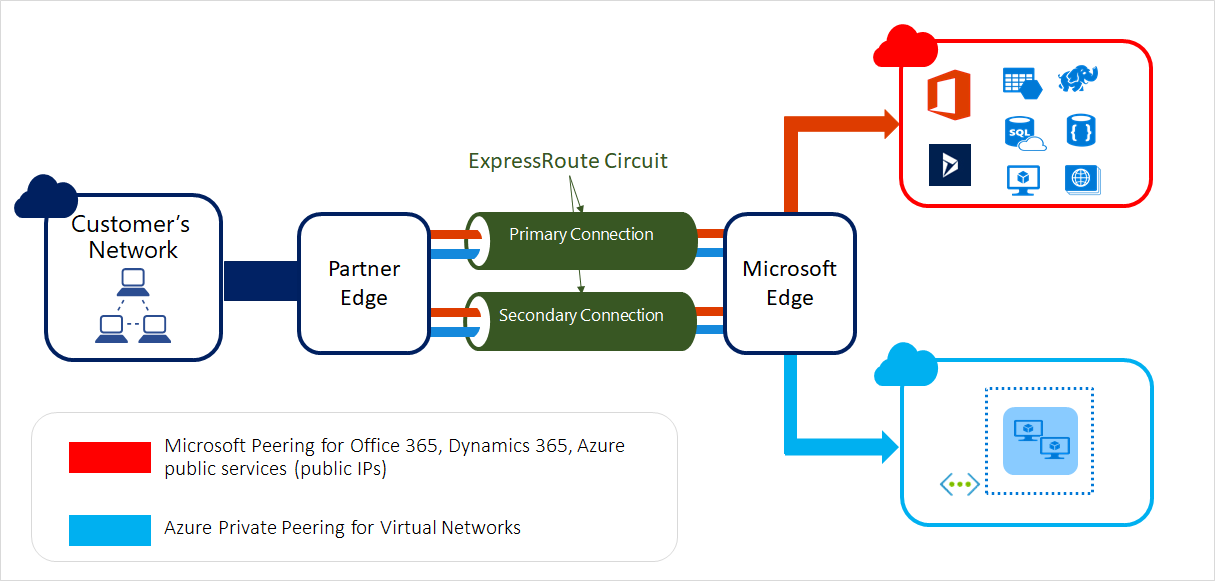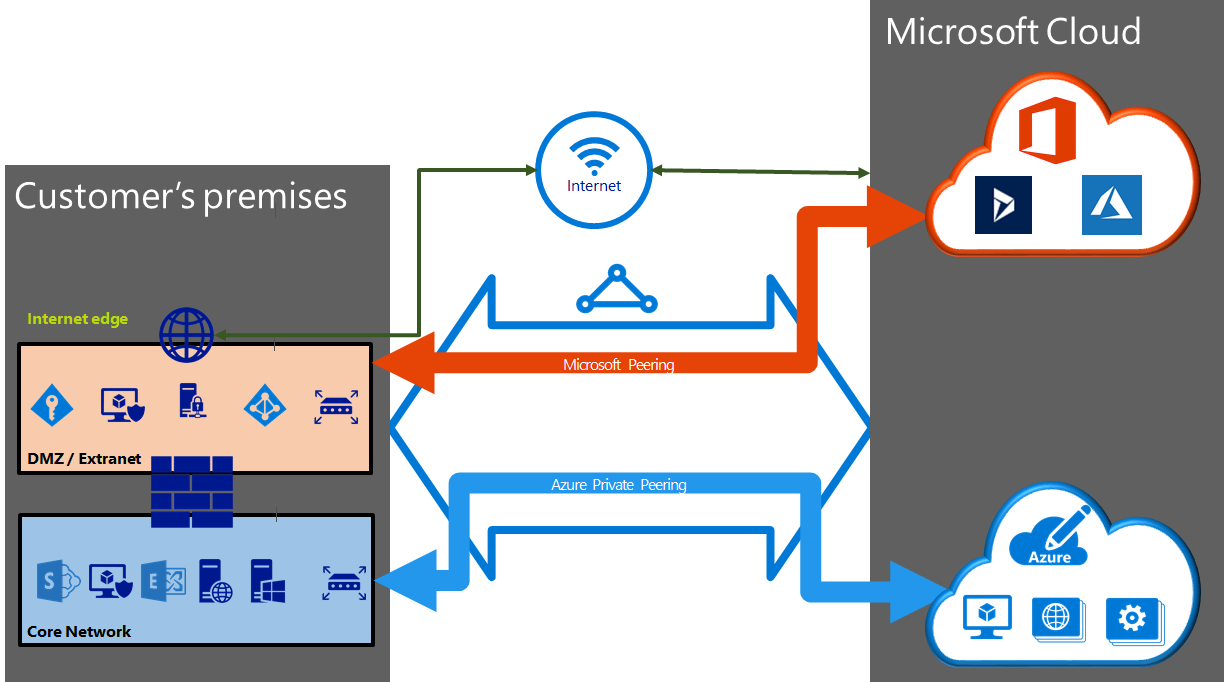ExpressRoute circuits and peering
ExpressRoute circuits connect your on-premises infrastructure to Microsoft through a connectivity provider. This article explains ExpressRoute circuits and routing domains/peering. The following diagram illustrates the logical connectivity between your WAN and Microsoft.

Note
In the context of ExpressRoute, the Microsoft Edge refers to the edge routers on the Microsoft side of the ExpressRoute circuit. This is the entry point of the ExpressRoute circuit into Microsoft's network.
ExpressRoute circuits
An ExpressRoute circuit is a logical connection between your on-premises infrastructure and Microsoft cloud services through a connectivity provider. You can have multiple ExpressRoute circuits, each in the same, or different regions, connected to your premises through different connectivity providers.
ExpressRoute circuits are identified by a standard GUID called a service key (s-key). The s-key is the only information exchanged between Microsoft, the connectivity provider, and you. It isn't a secret for security purposes. Each ExpressRoute circuit has a unique s-key.
New ExpressRoute circuits can include two independent peerings: Private peering and Microsoft peering. Each peering consists of a pair of independent BGP sessions, configured redundantly for high availability. An ExpressRoute circuit can have one, two, or all three peerings enabled.
Each circuit has a fixed bandwidth (50 Mbps, 100 Mbps, 200 Mbps, 500 Mbps, 1 Gbps, 2 Gbps, 5 Gbps, 10 Gbps) shared across all circuit peerings and is mapped to a connectivity provider and a peering location.
Quotas, limits, and limitations
Default quotas and limits apply to every ExpressRoute circuit. Refer to the Azure Subscription and Service Limits, Quotas, and Constraints page for up-to-date information.
Circuit SKU upgrade and downgrade
Allowed workflow
- Upgrade from Standard to Premium SKU.
- Upgrade from Local to Standard or Premium SKU (using Azure CLI or Azure PowerShell, with billing type as unlimited).
- Change from MeteredData to UnlimitedData.
- Downgrade from Premium SKU to Standard.
Unsupported workflow
- Change from UnlimitedData to MeteredData.
ExpressRoute peering
An ExpressRoute circuit has two routing domains/peerings: Azure Private and Microsoft. Each peering is configured identically on a pair of routers for high availability. Azure services are categorized as Azure public and Azure private to represent the IP addressing schemes.

Azure private peering
Azure compute services, such as virtual machines (IaaS) and cloud services (PaaS), deployed within a virtual network can be connected through the private peering domain. This domain is considered a trusted extension of your core network into Microsoft Azure. You can set up bi-directional connectivity between your core network and Azure virtual networks (VNets), allowing you to connect to virtual machines and cloud services directly on their private IP addresses.
You can connect multiple virtual networks to the private peering domain. Review the FAQ page for information on limits and limitations. Visit the Azure Subscription and Service Limits, Quotas, and Constraints page for up-to-date information. Refer to the Routing page for detailed routing configuration information.
Microsoft peering
Microsoft 365 was created to be accessed securely and reliably via the Internet. Because of this, we recommend ExpressRoute for specific scenarios. For information about using ExpressRoute to access Microsoft 365, visit Azure ExpressRoute for Microsoft 365.
Connectivity to Microsoft online services (Microsoft 365, Azure PaaS services, and Microsoft PSTN services) occurs through Microsoft peering. This peering enables bi-directional connectivity between your WAN and Microsoft cloud services. You must connect to Microsoft cloud services over public IP addresses owned by you or your connectivity provider and adhere to all defined rules. For more information, see the ExpressRoute prerequisites page.
For more information on supported services, costs, and configuration details, see the FAQ page. For a list of connectivity providers offering Microsoft peering support, see the ExpressRoute locations page.
Important
If you're connecting to a service using Microsoft Peering with unlimited data, only egress data won't be charged by ExpressRoute. Egress data will still be charged for services such as compute, storage, or any other services accessed over Microsoft peering, even if the destination is a Microsoft peering public IP address.
Peering comparison
The following table compares the two peerings:
| Private Peering | Microsoft Peering | |
|---|---|---|
| Max. # IPv4 prefixes supported per peering | 4000 by default, 10,000 with ExpressRoute Premium | 200 |
| Max. # IPv6 prefixes supported per peering | 100 | 200 |
| IP address ranges supported | Any valid IP address within your WAN. | Public IP addresses owned by you or your connectivity provider. |
| AS Number requirements | Private and public AS numbers. You must own the public AS number if you choose to use one. | You can set private and public AS numbers for peer ASN. However, you must prove ownership of public IP addresses. Note: If you use customer ASN, you can set public ASN only. |
| IP protocols supported | IPv4, IPv6 | IPv4, IPv6 |
| Routing Interface IP addresses | RFC1918 and public IP addresses | Public IP addresses registered to you in routing registries. |
| MD5 Hash support | Yes | Yes |
You may enable one or more routing domains as part of your ExpressRoute circuit. You can choose to have all routing domains on the same VPN or separate them into different routing domains. The recommended configuration is to connect private peering directly to the core network, and public and Microsoft peering links to your DMZ.
Each peering requires separate BGP sessions (one pair for each peering type). The BGP session pairs provide a highly available link. If you're connecting through layer 2 connectivity providers, you're responsible for configuring and managing routing. Learn more by reviewing the workflows for setting up ExpressRoute.
ExpressRoute health
ExpressRoute circuits can be monitored for availability, connectivity to VNets, and bandwidth utilization using ExpressRoute Network Insights.
Connection Monitor for ExpressRoute monitors the health of Azure private peering and Microsoft peering. For more information on configuration, see Configure Connection Monitor for ExpressRoute.
Next steps
- Find a service provider. See ExpressRoute service providers and locations.
- Ensure that all prerequisites are met. See ExpressRoute prerequisites.
- Configure your ExpressRoute connection.